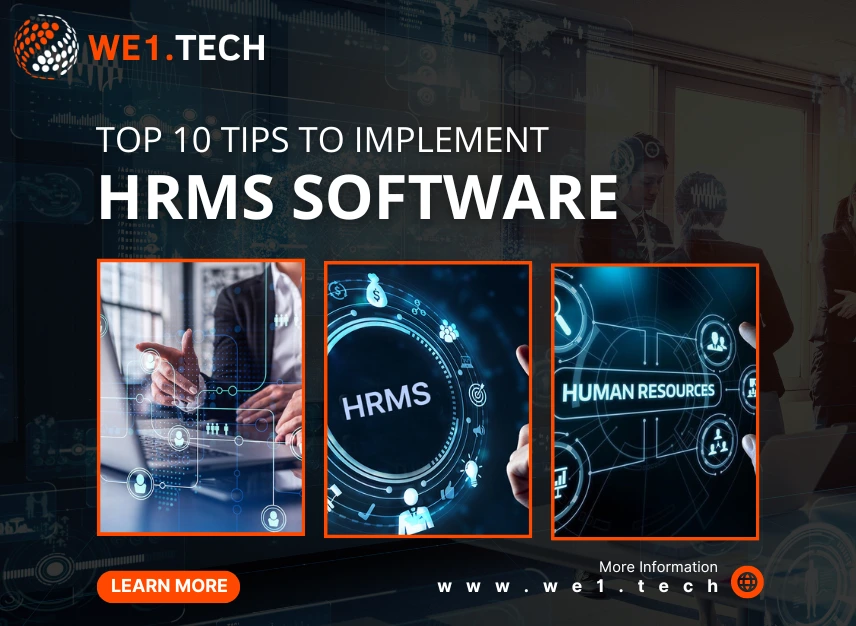
It goes without saying that employees are the most valuable assets of an organization. The success of any enterprise significantly depends on efficient human resource management, making it imperative to streamline HR-related processes. Today's modern workplaces demand modern solutions, and thus the implementation of HRMS software emerges as a game-changing solution. HRMS automates and optimizes several HR operations, from recruitment and onboarding to payroll and performance reviews. Implementing this software is not just a technological upgrade; it's a strategic investment to foster overall operational efficiency.
In this particular blog post, we will explore the top 10 tips for successfully implementing HRMS software, shedding light on how this robust technology can revolutionize your business. So, let's get started!
Introduction to Human Resource Management Software (HRMS)
At its core, Human Resource Management System (HRMS) is a comprehensive software suite that automates, streamlines, and tracks several HR processes within an organization. In today's modern workplace landscape, implementing an HRMS system is imperative for organizational success. It comes with a set of modules that optimize the entire lifecycle of an employee—from recruitment and onboarding to training and payroll processing. It also includes a range of functionalities like attendance tracking, employee data management, payroll processing, performance evaluation, recruitment, and selection. Furthermore, features such as self-service portals empower employees to update personal details, request leaves, and gain access to important documents independently. Moreover, HRMS software facilitates strategic decision-making with insights from analytics and reporting features. For businesses, the benefits extend to increased cost savings, employee satisfaction, and productivity.
The Best Tips to Implement HRMS Software
Let's now take a look at the top tips for successful human resource management software implementation:
Assess Your Organizational Needs
Before you begin with the implementation process, conduct a comprehensive analysis of your organization's HR requirements, pain points, and workflows. Identify the areas for improvement where automation could help increase efficiency and effectiveness. Take into consideration aspects such as your existing HR processes, the size of your workforce, and any specific business needs. This thorough assessment will help you choose the HRMS software that aligns with your organizational goals and fosters growth.
Conduct Thorough Research
The next significant step is to explore several HRMS solutions available in the market. Then evaluate their features, functionalities, customer reviews, and vendor reputation. Look for a software service provider with a proven track record of delivering reliable solutions. Also, another tip is to take into account scalability so that the system can accommodate your growing organizational needs.
Define Clear Goals for HRMS Software Implementation
Clearly outline the objectives you aim to achieve with the implementation of the human resource management system. Whether it's increasing efficiency, reducing manual errors, or improving employee engagement, having well-defined goals provides direction and allows for a more targeted and successful implementation process.
Look for Right Features and Functions
Another tip is to identify specific features and functions your organization requires to manage its workflows. This may include modules for applicant tracking, recruitment, onboarding, training, payroll processing, performance evaluation, real-time reporting, and more. You can select the modules that you require and enjoy extended benefits.
Customization and Configuration
Choose an HRMS system that allows for customization and configuration to adapt to your organization's unique workflow requirements. Customization ensures that the software aligns closely with your existing processes, reducing resistance to change among employees and enhancing the overall efficiency of the HR department. Configuration options should be user-friendly to facilitate seamless adaptation to evolving business needs.
Select the Right Software Service Provider
Look for a reputable HRMS software provider that has experience in delivering reliable IT solutions. Consider factors such as customization options, cost-efficiency, industry-specific features, and scalability. Conduct thorough research on the vendor's reviews, reputation, and request for demonstration. The demo will certainly ensure that the software selected is suitable for your organization's goals.
Prioritize Data Security
Safeguarding sensitive employee data is extremely essential. Prioritize human resource management solutions with robust security features, including access controls, end-to-end encryption, and regular security updates. Ensure compliance with data protection regulations to avoid legal implications. Conduct regular security audits to identify and address potential threats.
Invest in Training and Support
Proper training for HR staff and end-users is necessary for successful HRMS implementation. Allocate resources for training programmes and sessions to familiarize users with the software's features and functionalities. Additionally, ensure that the chosen software service provider offers reliable customer support to address any issues or queries quickly.
Testing and Quality Assurance
Having thorough testing before final implementation is important to identify and rectify any bugs, glitches, or compatibility issues. Establish a testing protocol that includes several scenarios and user interactions. Quality assurance is crucial to ensuring the smooth functioning of the HRMS, preventing disruptions in day-to-day HR-related operations.
Continuous Improvement and Maintenance
Implementing a human resource management system is an ongoing process. Regularly assess the system's performance, take feedback from users, and solve any emerging issues promptly. Plan for regular updates and improvements to keep the software up-to-date with evolving business needs and technological advancements. Establish a dedicated IT team for system improvement and maintenance.